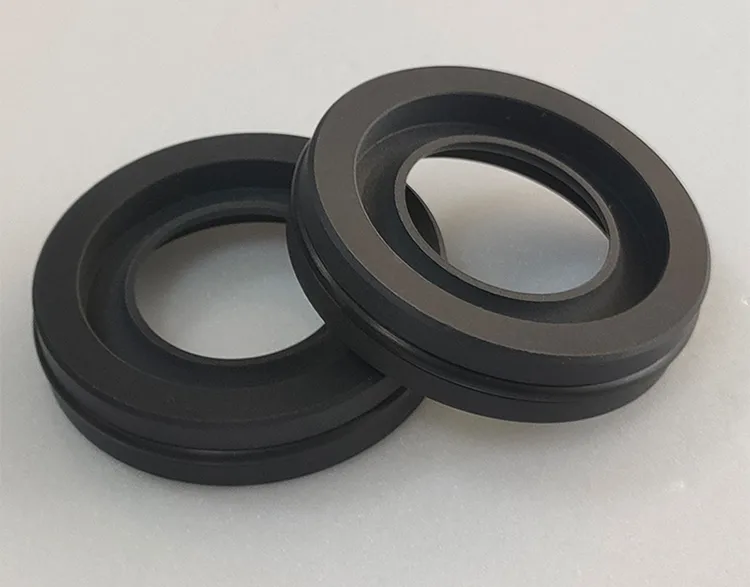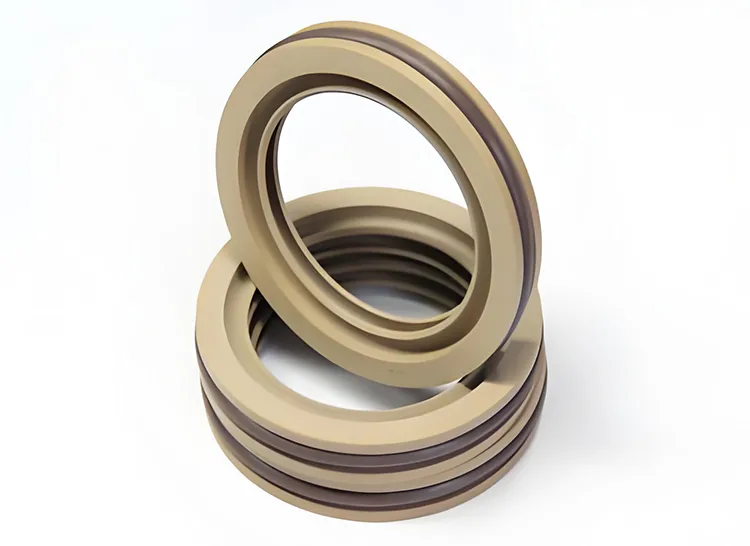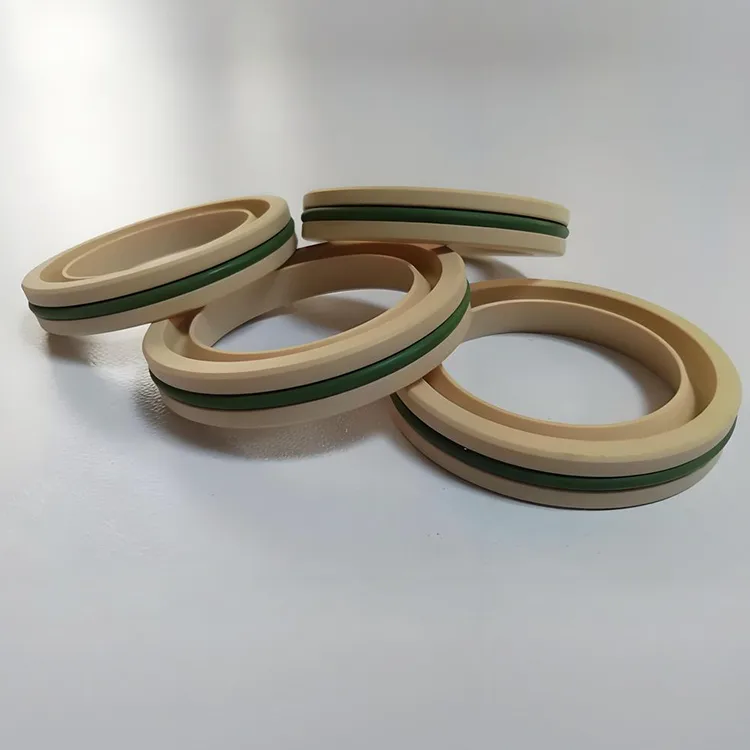1. Problem: Why Choosing the Right Seal Material Matters
Reciprocating seals are used in some of the most demanding industrial environments—such as hydraulic cylinders, pneumatic systems, and processing equipment. Unlike static seals that simply sit in place, reciprocating seals must endure continuous movement, high pressures, temperature fluctuations, and exposure to potentially aggressive fluids. This combination of conditions creates a narrow performance window where material properties play a decisive role.
When the seal material is not properly matched to the application, several critical issues can arise:
- Premature wear and leakage caused by excessive friction or poor compatibility with the operating medium.
- Extrusion and deformation due to inadequate hardness or poor resistance to pressure.
- Chemical degradation, such as swelling, cracking, or hardening of the elastomer.
- Stick-slip motion, leading to irregular movement, energy loss, and eventual equipment failure.
These problems don’t just affect the seal—they compromise the entire system’s performance. Unplanned maintenance, downtime, and component replacement can quickly outweigh the initial cost of the seal itself. That’s why careful material selection is the first line of defense in ensuring long-term sealing reliability in reciprocating applications.
2. Solution: Matching Seal Material to Application Conditions
Every reciprocating system demands a balance between sealing performance, wear life, and operational stability. A well-designed seal isn’t just about shape or installation—it’s fundamentally about choosing the right material for the job. The correct elastomer or PTFE-based compound can handle pressure, temperature, friction, and chemical exposure without compromising performance.
A well-matched material provides four critical advantages:
- ✅ Stable sealing performance under varying pressures and temperature swings
- 🛡️ High resistance to wear caused by repetitive motion and fluid friction
- 🧪 Chemical compatibility with oils, coolants, solvents, and other process media
- 🔁 Consistent elasticity and low stick-slip for smooth reciprocating movement
This decision goes beyond the seal itself. Material properties directly influence:
- The required surface finish and hardness of the mating shaft or bore
- The gland geometry and extrusion gap tolerances
- The lubrication strategy to manage friction and wear
- The use of back-up rings, wipers, or support elements for reinforcement
In short, proper material selection ensures the seal works as a system, not as a single part. By understanding the interaction between the seal material and its operating environment, engineers can significantly extend service life and reduce total cost of ownership.

3. Key Considerations When Selecting Materials for Reciprocating Seals
Choosing the right material isn’t just about picking something that “fits.” It requires a technical match between the seal’s properties and the real-world operating conditions it will face. Below are the most critical factors engineers and buyers must evaluate when specifying materials for reciprocating seals.
3.1 Understanding the Demands of Reciprocating Seals
Reciprocating seals operate in dynamic environments where motion, pressure, and media exposure constantly challenge their integrity. Unlike static seals, they must maintain tight sealing while sliding against a moving surface—often at high speed and under fluctuating loads.
- High pressures increase the risk of extrusion and deformation.
- Frictional heat accelerates wear and chemical degradation.
- Abrasive contaminants can damage softer materials.
- Misalignment or poor surface finish can shorten service life.
3.2 Common Elastomer and PTFE-Based Material Options
| Material | Temperature Range | Strengths | Typical Applications |
|---|---|---|---|
| NBR (Nitrile) | –30 °C to +100 °C | Good oil resistance, cost-effective | Hydraulic & pneumatic systems |
| HNBR | –30 °C to +150 °C | Improved heat & chemical resistance over NBR | High-pressure oil systems |
| FKM | –20 °C to +200 °C | Excellent chemical resistance and heat stability | Chemical processing, high-temp |
| PU (Polyurethane) | –40 °C to +100 °C | Outstanding abrasion resistance, high tensile strength | Heavy-duty hydraulic systems |
| PTFE | –200 °C to +260 °C | Low friction, chemically inert, broad temperature range | High-speed or aggressive media |
| EPDM | –50 °C to +150 °C | Resistant to steam, hot water, polar solvents | HVAC, food processing |
| Silicone | –60 °C to +200 °C | Flexible at low temperatures, FDA-grade options | Food, pharma, low-pressure seals |
📝 Note: Each material has trade-offs. For example, PU offers great wear resistance but can be sensitive to high temperatures, while PTFE excels in harsh conditions but requires precise gland design.
3.3 Matching Material to Application Conditions
The operating environment determines which compound will perform best:
- Pressure: High pressures may demand PU or reinforced PTFE for extrusion resistance.
- Temperature: FKM or PTFE suits elevated temperatures; EPDM and silicone excel in low-temp or steam applications.
- Chemicals: FKM and PTFE provide superior resistance to oils, solvents, and aggressive media.
- Speed & Friction: PTFE is ideal for low-friction applications; PU and HNBR balance cost and performance.
3.4 Supporting Design Factors
Material choice is only effective when combined with good system design.
- Surface finish: A smoother surface minimizes friction and wear.
- Hardness: Proper hardness pairing between the seal and mating parts reduces damage.
- Gland design: Tolerances must control extrusion without over-compressing the seal.
- Lubrication: The right lubricant or fluid helps extend service life.
4. Practical Material Selection Scenarios
To make the right material choice for reciprocating seals, theory alone isn’t enough. Engineers need real-world selection logic that matches material behavior to specific working conditions. Below are typical scenarios where different elastomer and PTFE-based compounds excel.
4.1 High-Pressure Hydraulic Cylinders
Typical Conditions:
- Pressure: up to 25 MPa or higher
- Medium: hydraulic oil
- Temperature: –20 °C to +100 °C
- Movement: fast reciprocating motion with long stroke lengths
Recommended Materials:
- PU (Polyurethane) — excellent extrusion resistance and wear strength, ideal for rod and piston seals.
- HNBR — suitable for applications requiring better heat and oil resistance than NBR.
- PTFE + Energizer — best for ultra-high pressure or when low friction is critical.
Why: High pressure increases the risk of extrusion and lip damage. PU and HNBR maintain shape and resilience, while PTFE reduces friction and improves service life in heavy-duty systems.
4.2 Low-Temperature Pneumatic Equipment
Typical Conditions:
- Pressure: moderate
- Temperature: down to –40 °C
- Medium: compressed air or inert gas
- Speed: fast cycles with light loads
Recommended Materials:
- Silicone — excellent flexibility at low temperatures, FDA-compliant for sensitive environments.
- EPDM — good elasticity, stable sealing under cold and moist conditions.
- NBR — cost-effective choice for general pneumatic applications.
Why: Low temperatures make many elastomers brittle. Silicone and EPDM retain elasticity and prevent leakage from cold shrinkage or hardening.
4.3 Chemical and Solvent-Rich Process Environments
Typical Conditions:
- Temperature: –20 °C to +200 °C
- Medium: solvents, fuels, corrosive fluids
- Pressure: medium to high
- Exposure: continuous or intermittent
Recommended Materials:
- FKM — excellent chemical and temperature resistance, stable sealing performance.
- PTFE — best option for aggressive chemicals and long-term durability.
- EPDM — suitable for polar solvents and steam (but not oils).
Why: In chemically aggressive environments, material compatibility is the key to preventing swelling, cracking, or degradation over time.
4.4 High-Speed Reciprocating Shafts
Typical Conditions:
- High stroke frequency
- Elevated surface temperatures
- Minimal lubrication or dry-running periods
Recommended Materials:
- PTFE — ultra-low friction, ideal for reducing heat build-up.
- PU — offers wear resistance and good resilience under fast motion.
- FKM — good high-temperature stability.
Why: At high speeds, excessive friction accelerates wear. PTFE minimizes friction, while PU maintains dimensional stability.
4.5 Food and Medical-Grade Applications
Typical Conditions:
- Temperature: variable
- Media: water, steam, cleaning agents
- Compliance: FDA, EU regulations
Recommended Materials:
- Silicone — soft, clean, and flexible at extreme temperatures.
- EPDM — steam and cleaning agent resistant.
- PTFE — suitable for aggressive cleaning chemicals and CIP/SIP systems.
Why: These applications require both chemical resistance and compliance with hygiene standards. Silicone and PTFE provide excellent performance with minimal contamination risk.

5. Supporting Factors Beyond Material
While material selection is the foundation of a reliable reciprocating seal, it alone cannot guarantee long-term performance. A seal functions as part of a complete system—including the mating surfaces, gland design, lubrication strategy, and surrounding protective components. These supporting factors are often the decisive elements that determine whether a seal achieves its expected service life or fails prematurely.
5.1 Surface Finish and Shaft Hardness
The interaction between the seal and the shaft or bore surface is critical.
- A smooth surface finish (typically Ra 0.2–0.4 µm for dynamic seals) minimizes wear and reduces friction.
- A harder shaft surface (e.g., ≥ 55 HRC) protects against scoring, especially when using softer elastomers like NBR or PU.
- Excessively rough surfaces can abrade the seal lip, while surfaces that are too smooth can cause inadequate lubrication retention.
5.2 Gland Design and Extrusion Gap
Even the best material can fail if the gland geometry isn’t right.
- The extrusion gap must be controlled according to the material’s hardness and pressure rating.
- Tighter tolerances reduce the risk of material extrusion at high pressures.
- PTFE and PU seals require more precise gland control compared to softer elastomers.
5.3 Lubrication Strategies
Friction and heat build-up are major causes of premature seal failure.
- A well-selected lubricant or system fluid acts as both a protective film and a cooling medium.
- Materials like PTFE naturally offer low friction, while elastomers like PU and NBR benefit greatly from proper lubrication.
- In dry-running or intermittent lubrication cases, PTFE-based compounds often perform best.
5.4 Protective Components and Reinforcements
Supporting elements such as wipers, back-up rings, and wear rings significantly extend seal life.
- Wipers prevent contaminants from entering the gland and damaging the seal lip.
- Back-up rings reduce extrusion risk in high-pressure applications.
- Wear rings or guide rings help maintain alignment and distribute side loads, protecting the seal from uneven wear.
5.5 Maintenance and Installation Practices
The final step in ensuring sealing reliability is correct installation and maintenance.
- Avoid sharp edges or burrs during assembly.
- Pre-lubricate seals to prevent dry friction at start-up.
- Periodic inspection of rod alignment, surface wear, and leakage helps catch issues early.
- Proper storage (controlled temperature, humidity, UV protection) preserves elastomer integrity before installation.
6. Key Takeaways
Material selection for reciprocating seals is not just a design step — it’s a strategic decision that impacts performance, maintenance cycles, and total cost of ownership. The right choice helps systems run longer, safer, and more efficiently, while the wrong choice can trigger a chain reaction of problems: leakage, wear, downtime, and expensive repairs.
Here are the essential lessons to keep in mind:
- Material defines performance. NBR, HNBR, FKM, PU, PTFE, EPDM, and silicone each have unique strengths and limits. Understanding their properties allows you to match the right compound to your application.
- System conditions drive the choice. Pressure, temperature, chemical compatibility, speed, and stroke length should guide material selection—not habit, price, or availability alone.
- Design and environment matter. Even the best material can fail if gland geometry, surface finish, or lubrication are not properly controlled.
- Supporting components extend life. Back-up rings, wipers, and wear rings aren’t optional—they protect seals and help them perform consistently under demanding conditions.
- Proactive maintenance saves money. Proper installation, storage, and regular inspections can dramatically reduce unplanned downtime and extend seal service life.
7. Conclusion: Turning Material Selection into Reliable Performance
Choosing the right material for reciprocating seals is more than a technical choice — it’s a strategic decision that determines system reliability, maintenance cycles, and long-term cost. The process should be simple but structured:
- Define operating conditions — pressure, temperature, medium, and motion profile.
- Match material properties — select the compound that best fits performance and chemical resistance needs.
- Optimize system design — ensure gland geometry, surface finish, and lubrication align with the chosen material.
- Validate before scaling — test performance under realistic conditions.
- Work with experienced partners — professional support ensures the material and design are fully aligned.
When material choice is backed by solid engineering and practical testing, reciprocating seals can achieve long-lasting, stable, and cost-efficient performance.

